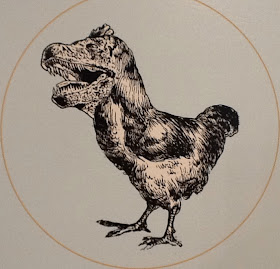 Dinosaurs: Non-Crocodylian Archosauromorphs
Dinosaurs: Non-Crocodylian ArchosauromorphsThere have been 1,000 species of dinosaurs discovered! The Dinosauria clade within Archosauromorpha is sister to Crocodilotarsi and maybe even Testudines. Dinosauria are ornithodontids which demonstate: supra-acetabular crest, antorbital fenestra, enlarged fourth trochanter and digitigrade stance on the tips of toes. During the Mesosozic "Age of the Dinosaurs" 220-65 mya these astounding reptiles there were two prominent clades that existed: Saurischia and Ornithischia. We traveled to the Cleveland Museum of Natural History ,which has an impressive collection of some of these specimens, to learn more than we could in the lab.
 First, we looked at the Nannotyrannus and determined that it was similar to the Tyrannosaur through the position of the pubis and condition of the fenestra. Therefore the Nannotyrannus and Tyrannosaurus rex are Saurischians. The key indicator was seeing the 3-pronged pelvic girtle with pubis extended anteriorly and ventrally.
First, we looked at the Nannotyrannus and determined that it was similar to the Tyrannosaur through the position of the pubis and condition of the fenestra. Therefore the Nannotyrannus and Tyrannosaurus rex are Saurischians. The key indicator was seeing the 3-pronged pelvic girtle with pubis extended anteriorly and ventrally.
 The Triceratops horridis we looked at is a classic example of an Ornithiscian dinosaurs.
The Triceratops horridis we looked at is a classic example of an Ornithiscian dinosaurs.  Ornithiscian dinosaurs have a pubis that extends posteriorly from the pelvic girdle, a reduced and antorbital fenestra, the ventral margin of which parallels the maxillary tooth row.
Ornithiscian dinosaurs have a pubis that extends posteriorly from the pelvic girdle, a reduced and antorbital fenestra, the ventral margin of which parallels the maxillary tooth row.The Tyrannosaurus rex we saw had a three pronged pelvic girdle with an anterior pubis.
The mammals we saw possessed the obvious synapsid skull. They did not have a protruding pubis in the pelvic girdle.
We also looked at an extinct predatory bird, Diatryma. We noticed the placement of the ilium contecting the vertebrae, ischium and pubis. This predatory bird demonstrated the posterior pubis of ornithischia.



We then observed the skulls of the extinct mammals (Irish Elk, Saber-tooth Cat, Glyptodont, Mammoth, and Mastodon) dinosaurs and none possessed
 antorbital fenestrae. They all had synapsid skulls typical of Mammalia, meaning they had a single subtemporal fenestra.
antorbital fenestrae. They all had synapsid skulls typical of Mammalia, meaning they had a single subtemporal fenestra. When we looked at the Corythosaurus, Parasauralophus, and Edmontosaurus: The Edmontosaurus skeleton had a posterior pubis and the skulls lacked antorbital fenestra which makes these mammals ornithischian.
When we looked at the Corythosaurus, Parasauralophus, and Edmontosaurus: The Edmontosaurus skeleton had a posterior pubis and the skulls lacked antorbital fenestra which makes these mammals ornithischian. We then observed a display called "Prey Meet Predator" and observed the limbs and girtles of the Haplocanthosaurus delfsi (plant-eating prey) and Allosaurus fragilis (carniferous predators). An interesting fact we found out with that though Allosaurus was half the size of its prey, they may have succeeded in preying on the Haplocanthosaurus by hunting in packs, not unlike wolves! From the anterior orientation of the pubis in both specimens, we concluded that they were both saurischian dinosaurs.
We then observed a display called "Prey Meet Predator" and observed the limbs and girtles of the Haplocanthosaurus delfsi (plant-eating prey) and Allosaurus fragilis (carniferous predators). An interesting fact we found out with that though Allosaurus was half the size of its prey, they may have succeeded in preying on the Haplocanthosaurus by hunting in packs, not unlike wolves! From the anterior orientation of the pubis in both specimens, we concluded that they were both saurischian dinosaurs.
 Moving along to the aquatic dinosaurs, we observed the fenestration of the Phytosaurus, Ichthyosaurus, and Stenopterygius.
Moving along to the aquatic dinosaurs, we observed the fenestration of the Phytosaurus, Ichthyosaurus, and Stenopterygius.We concluded that the Phytosaurus, or a Crocodile-like Reptile (above), was diapsid;
Ichthyosaurus, a Marine Fish-like Reptile (right), was eurya
and Stenopterygius, a Primative Marine Crocodile (below), was also euryapsid.

We then took a detour to the basement of the museum where our museum guide showed us they kept live specimens for teaching demos. Cait pet her first live snake!
After that, we moved on to the Dimetrodon limbatus (below) which clearly demonstrated synapsid fenestration (not a diapsid because it didn't have a supraorbital fenestra).

We ended the lab with a very important specimen. Sphenodon punctatus, the Tuatara, is a modern nocturnal, insect-eating reptile with a lifespan of 100 years or more. It is currently still found in New Zealand. The special thing about this reptile is that its primitive skeletal structure has remained UNCHANGED from it's Triassic ancestral condition. This means paleontologists and artists can use it to make inferences about the appearance and behavior of extinct reptiles!

We'll leave you with this awesome illustration/fun fact we saw at the CMNH of a Tyrannosaurus rex possibly having had feathers when young to keep warm similar to modern birds. This hypothesis was suggested because of their complex behavior and morphological similarities to birds already, such as hollow bones, nest building and caring for young (and notice the little arms):
 xxxx
xxxx
No comments:
Post a Comment